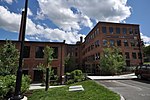Williams College
Williams College is a private liberal arts college in Williamstown, Massachusetts. It was established as a men's college in 1793 with funds from the estate of Ephraim Williams, a colonist from the Province of Massachusetts Bay who was killed in the French and Indian War in 1755. Williams's main campus is located in Williamstown, in the Berkshires in rural northwestern Massachusetts, and contains more than 100 academic, athletic, and residential buildings. There are 360 voting faculty members, with a student-to-faculty ratio of 6:1. As of 2022, the school has an enrollment of 2,021 undergraduate students and 50 graduate students.Following a liberal arts curriculum, Williams College provides undergraduate instruction in 25 academic departments and interdisciplinary programs including 36 majors in the humanities, arts, social sciences, and natural sciences. Williams offers an almost entirely undergraduate instruction, though there are two graduate programs in development economics and art history. The college maintains affiliations with the nearby Clark Art Institute and the Massachusetts Museum of Contemporary Art (MASS MoCA), and has a close relationship with Exeter College, Oxford. The college competes in the NCAA Division III New England Small College Athletic Conference as the Ephs. Williams College has won 22 of the last 24 College Directors' Cups for NCAA Division III.Prominent alumni include 9 Pulitzer Prize winners, 2 Nobel Prize laureates, a Fields medalist, a Lasker award recipient, 16 billionaires, 71 members of the United States Congress, 22 U.S. Governors, 4 U.S. Cabinet secretaries, an Associate Justice of the Supreme Court, a President of the United States, 3 prime ministers, CEOs and founders of Fortune 500 companies, multiple Emmy, Oscar, Tony, and Grammy award winners, and professional athletes. Other notable alumni include 40 Rhodes Scholars and 17 Marshall Scholarship recipients.
Excerpt from the Wikipedia article Williams College (License: CC BY-SA 3.0, Authors).Williams College
Main Street,
Geographical coordinates (GPS) Address Nearby Places Show on map
Geographical coordinates (GPS)
| Latitude | Longitude |
|---|---|
| N 42.7125 ° | E -73.205 ° |
Address
West College
Main Street 931
01267
Massachusetts, United States
Open on Google Maps









